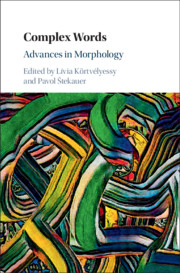Book contents
- Complex Words
- Complex Words
- Copyright page
- Dedication
- Contents
- Contributors
- Introduction: Advances in Morphology
- Part I Lexico-Semantic Aspects of Complex Words
- Part II Structure of Complex Words
- Part III Corpus-Based Case Studies
- 13 Competition between Synthetic NN Compounds and NN.gen Phrasal Nouns in Polish
- 14 An S Is an ’S, or Is It? Plural and Genitive Plural Are Not Homophonous
- 15 The Role of Word-Formation Families and Subfamilies in the Organization of German Diminutive Compounds
- 16 Semantic Patterns in Noun-to-Verb Conversion in English
- 17 Onomatopoeia
- 18 Dingsbums and Thingy
- Index
- References
13 - Competition between Synthetic NN Compounds and NN.gen Phrasal Nouns in Polish
Semantic Niches, Hapax Legomena and Low-Level Construction Schemas
from Part III - Corpus-Based Case Studies
Published online by Cambridge University Press: 18 September 2020
- Complex Words
- Complex Words
- Copyright page
- Dedication
- Contents
- Contributors
- Introduction: Advances in Morphology
- Part I Lexico-Semantic Aspects of Complex Words
- Part II Structure of Complex Words
- Part III Corpus-Based Case Studies
- 13 Competition between Synthetic NN Compounds and NN.gen Phrasal Nouns in Polish
- 14 An S Is an ’S, or Is It? Plural and Genitive Plural Are Not Homophonous
- 15 The Role of Word-Formation Families and Subfamilies in the Organization of German Diminutive Compounds
- 16 Semantic Patterns in Noun-to-Verb Conversion in English
- 17 Onomatopoeia
- 18 Dingsbums and Thingy
- Index
- References
Summary
This paper discusses synthetic compounds in Polish, focusing on compound nouns which contain either a deverbal suffixal derivative or a nominalized verb stem as their right-hand constituent. Competition is investigated between such right-headed morphological compounds and left-headed phrasal nouns consisting of a head noun followed by its genitive attribute. Furthermore, Polish compound nouns are compared, in respect of their productivity and their semantic interpretation, with Japanese compound nouns headed by nominalized verb stems, and with English synthetic compounds. Examples are provided (on the basis of the National Corpus of Polish and Google searches) of non-institutionalized Polish compound nouns (with agentive or event reading) which can be viewed as forming semantic niches (in the sense of Hüning 2009), extendable through analogy. It is argued that the framework of Construction Morphology (as outlined by Booij 2010), with its postulation of low-level construction schemas, can provide an appropriate account of the process of analogical compound formation in Polish.
- Type
- Chapter
- Information
- Complex WordsAdvances in Morphology, pp. 241 - 259Publisher: Cambridge University PressPrint publication year: 2020

